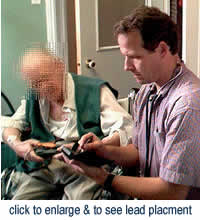| |
|
ActiveECG
review, page 3: In a Doctor's Office
|
By: Alec Cooper MD
 |
A few weeks ago, a 79 year old gentleman with a history
of Chronic Obstructive Pulmonary Disease and Biventricular
Heart Failure came to my office on a routine visit. He
has over the last year developed a tendency to pop in
and out of pulmonary edema with the slightest cold or
runny nose. I see him weekly in order to check and adjust
his Lasix and anti-hypertensives.
|
On this visit I perceived an irregularly irregular heartbeat while
taking his blood pressure and I feared that he may have newly developed
atrial fibrillation, perhaps due to cardiac dilatation secondary
to inadequate diuresis over the previous week.
In my family medicine clinic, I would have ordinarily sent this
patient to the hospital emergency room next door for an ECG, but
this time I had another trick up my sleeve (almost literally!).
I reached into my medical bag and pulled out "ActiveECG", a Palm
handheld-sized device and a portable hot-sync cable. Slipping my
Palm IIIc out of my pocket, I then connected it to the device, unravelled
three wires from a moulded plastic "raceway" on the device's flat
surface, connected them to the patient with three sticker-electrodes
and presto, within 30 seconds I was watching this patient's cardiac
rhythm on my Palm IIIc screen. The rhythm plainly showed occasional
premature ventriclar singlets with no fibrillation, and I was able
to confidently reassure myself and my patient that no visit to the
Emergency Room was necessary this time around.
This case differed from another one I had seen the previous week
where another cardiac patient came to my weekly walk-in clinic with
his home-care nurse. He was complaining of shortness of breath.
On exam, he was pale and his pulse was rapid. Within a minute, I
had a rhythm strip of rapid atrial fibrillation recorded in my Palm
IIIc memory. I called my secretary Manon, giving her my handheld
for hot-syncing on the cradle I have permanently connected at her
Windows work station. While I telephoned the duty emergency physician,
Manon printed out the strip on a neatly formatted page containing
all the data I had entered on the Palm IIIc; (name, age of patient,
date, time of strip), and of course, the strip, with standard ECG
gridding: all this onto a blank sheet of standard office paper,
thanks to the ActiveECG software that is supplied with this remarkable
Palm OS accessory.
I sent this sheet off with the patient to Emergency, printing
out an identical second sheet for my office chart. A few eyebrows
were doubtless raised amongst the triage nursing and medical staff
and the hospital next door, all the while saving precious pre-hospital
diagnostic time.
The hardware is robust and as easy to hook up to a Palm OS handheld
as any portable hot sync cable or accessory. The screen display
is entered in the usual manner by tapping an icon that runs the
Palm OS-side of the software. It is easy to read, with centimeter-wide
buttons that can be customized to enter specific data such as custom
office chart numbers. I found the real-time moniter easy to read,
with excellent black/white contrast on a Palm IIIc. The number of
patient ECGs you can enter and save on your Palm OS Handheld is
only limited by the available memory (ie what other programs and
data you have on your device at the time).
I found Active ECG was indeed a welcome addition to my retinue
of Palm IIIc accessories that includes the Kodak PalmPix for photographing
wounds and skin infections, the Palm Keyboard for note taking, the
portable recharger, and extra cradles for the office.
Is it a "must have"? Well, I could see this device being especially
useful in the pre-hospital emergency "first-response" setting such
as is more frequently seen in paramedic and ambulance work. In the
two months I have carried this device around in my medical bag,
I have taken it out about a dozen times. That includes a couple
of "gadget demonstrations" for physician friends and family, a few
routine rhythm strips that I added to patient charts, and the two
cases described above. I have used the Active ECG on several housecall
visits as well. Finally, I used ActiveECG this morning to record
a strip on an asymptomatic patient. He graciously allowed a nurse
to photograph the procedure (with my wife's Palm + my PalmPix attachment)
for this article. In return for his kind cooperation, I was able
to assure him and his wife that their hearts were just fine.
ActiveECG is an extremely convenient if somewhat luxurious accessory
to have in a medical bag. As far as my part-time emergency room
work is concerned, the ActiveECG is not really useful except perhaps
as a far-fetched back-up system in the event of multiple-level power
failures affecting the usual cardiac monitering and ECG equipment!
All the same...the next time I'm at a public event or flying the
friendly skies, and that dreaded announcement "Is there a doctor
in the house ?" comes over the public address system... along
with a stethoscope and maybe a nitrospray puffer, I think I would
feel quite content knowing I had ActiveECG-enabled Palm handheld
along for the ride!
Alec Cooper, MD
drcooper.palm
|
|
ActiveECG review page: 1
2 3 4
|
 |
.gif)
|
|
